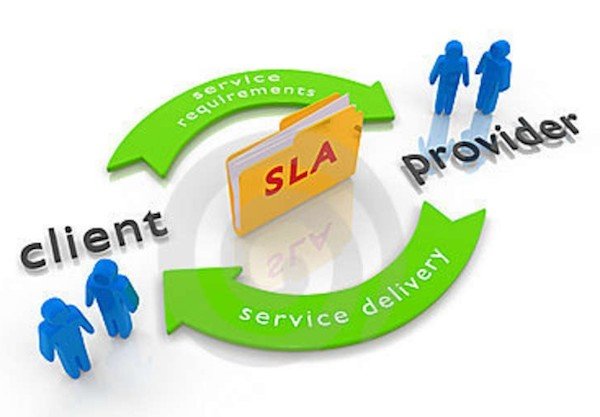11 Service Level Agreement Examples to Track your Service Management Metrics
What is a Service Level Agreement?
A service level agreement is a contract signed between two or more parties signifying both the requirements and expected level of services. The document determines the scope of work and aims to maintain the optimum level of performance required.
Since a client and service providers’ needs are pretty fluid, so as to keep a solid set of requirements and services, an SLA is needed.
These documents can be applied to a varied range of cases. However, before discussing various kinds of templates suiting different industries, which is the article’s intent, let’s talk a bit more about the significance of the same.
Why is it important to have a Service Level Agreement?
Anyone who has been part of a service-based industry knows the importance of SLAs. However, if you’re a newbie or someone who is still unsure about their relevance, continue on the path.
But, on the other hand, if you’re already experienced in the field, consider jumping to the next section- “11 service level agreement templates to track your service management metrics.”
Let’s assume you’re part of the freelance culture and provide writing services to a range of clients. However, you’re still in the initial stage of your career and have come across a client with personal relationships.
After discussing the initial set of requirements, you have started drafting write-ups, but after a while, the client began throwing snags, which weren’t addressed in the requirement stage- Images designed from scratch, fixed word count, limited allotted hours, every alternate day submissions, or something else.
In simple words, quality missed unexpected milestones, changed requirements, etc. Conclusively, the payments have been blocked, and you aren’t able to proceed forward.
No problem is a real problem unless it arises from both sides of the coin.
Assume you wish to get a dating app designed and have discussed the blueprint of the idea with the chosen service provider. However, after a while, you realize, neither the discussed features nor the mentioned budget is adhered to. And you’re pissed…!!
Regardless of whichever side of the wall you belong to, it isn’t a happy place!!
You see, lack of robust processes is the real problem. And we need an industry-accepted solution here. This is where SLAs come into the scene!
Service level agreements define the set of requirements and other intricacies of work via a signed document. This way, all the participants are aware of the project’s scope and very well know that the requirements can’t be changed at the last minute. The service provider can meet their targets quickly, and the client is aware of the expected output.
Therefore, SLAs are a must-have if you wish to run the operations smoothly.
You’re probably convinced of the importance these documents hold in customer-provider relationships, and you have gone a step further and drafted something in the name of SLA to be sure that you aren’t lagging.
However, not everything is an SLA, let alone be a good SLA.
A poorly drafted SLA may prove futile in the duration of a relationship. An SLA signed and shoved right into the filing cabinet isn’t going to do much for you. Therefore, it is essential to know the best practices while dealing with these contracts.
Hence, today in this article, we will discuss the various service level agreement templates for an improved Client- Service Provider Relationship and different commitments included in an SLA.
Curious, let’s start exploring what we have in the bucket.
Different kinds of commitments included in an SLA
There are different kinds of commitments that are included in a Service Level Agreement-
- Turn Around Time
Time around time is the total time required to complete a task. This metric is measured as mean, average, or maximum. - Customer Satisfaction
Customer services like help desk are usually estimated with the customer satisfaction rate - Backlog
This metric is used to estimate unfinished work with the average age of backlog. For instance, a help desk may commit that its request backlog won’t exceed 3 days. - Service Quality
It estimates the service quality by obtaining quantification. For instance, a communication platform may offer a call quality service in an SLA that can be acquired by asking people to rate the quality of calls. - Recovery Mean Time
It is used for estimating the meantime to recover from different incidents. - Mean Time Between Failures
It is used for estimating the meantime to recover from major incidents. - Uptime
Technology services use an uptime commitment, like 99.99%. This metric is also known as availability.
11 Service Level Agreement Templates to track your Service Management Metrics
- General Template
Let’s begin with the basic version before boiling it down to industry-specific service level agreement examples. This kind covers the most fundamental components of SLA, including-
- Agreement’s overview
- Agreement’s goal, purpose, and objectives
- Scope of project and expected service
- Customer and service provider requirements and responsibilities
- Performance Monitoring, Feedback, and Reviews
- Service management
- Lastly, the in-built approval stage.
| Title | Details |
| Introduction | Define the participants of the agreementCategory of the Services the organization belongs to |
| Agreement’s Purpose | Contains the Purpose of Agreement |
| Agreement’s Goal | Specifies goal of the Agreement |
| Agreement’s Objective | Mentions objective of the Agreement |
| Duration of Agreement | Certify the Lifespan of SLAConfirm Performance Review Protocols |
| Service Provider Services & Requirements | Draft a list of services to be provided. Detail the services to be provided. Enlist the service provider’s requirements |
| Customer Requirements | Enlist Customer Requirements Email the client regarding their requirements. Approval of customer requirements |
| Post Agreement Management | Confirm the methods to get in contact |
| Agreement Review | Double-check the draft of SLA |
| Handing over the Agreement | Sending emails to the customer in loopSteps for Customer Approval |
| Sending the Approved Agreement | Format the Agreement appropriately, Email the approved SLA to the customer |
| Sources | Enlist the sources |
| References | Enlist the references |
Also Read, 3 Ways to Bridge Trust Gap with Customers.
- SLA Management Checklist Template
After the generic piece, it is time for an advanced version. The agreement doesn’t end with document creation; instead, it includes a review period.
The review period is used to evaluate key performance indicators (KPIs) and other relevant metrics to ensure that performance standards match the current SLA.
Let’s assume that the review period is of 3 months for the below SLA template-
| Title | Details |
| Introduction | Define the participants of the agreement, Category of the Services the organization belongs to |
| Agreement’s Purpose | Contains the Purpose of Agreement |
| Agreement’s Goal | Specifies goal of the Agreement |
| Agreement’s Objective | Mentions objective of the Agreement |
| Duration of Agreement | Certify the Lifespan of SLAConfirm Performance Review Protocols |
| Service Provider Services & Requirements | Draft a list of services to be provided, Detail the services to be provided, Enlist the service provider’s requirements |
| Customer Requirements | Enlist Customer Requirements Email the client regarding their requirements, Approval of customer requirements |
| Post Agreement Management | Confirm the methods to get in contact |
| Agreement Review | Double-check the draft of SLA |
| Handing over the Agreement | Sending emails to the customer in loopSteps for Customer Approval |
| Sending the Approved Agreement | Format the Agreement appropriately, Email the approved SLA to the customer |
| Performance Review (Month 1) | Review current service requirements. Evaluate relevant metrics and other data. Confirm compliance with the SLA. Make necessary iterations to the SLA. Inform relevant personnel of shortcomings. |
| Performance Review (Month 2) | Review current service requirements. (month 2)Evaluate relevant metrics and other data. (month 2)Confirm compliance with the SLA. (month 2)Make necessary iterations to the SLA. (month 2)Inform relevant personnel of shortcomings. (month 2) |
| Performance Review (Month 3) | Review current service requirements. (month 3)Evaluate relevant metrics and other data. (month 3)Confirm compliance with the SLA. (month 3)Make necessary iterations to the SLA. (month 3)Inform relevant personnel of shortcomings. (month 3) |
| Sources | Enlist the sources |
| References | Enlist the references |
In case if you have to stretch the review process to say for six months, then simply duplicate the review tasks for every month and make minor variations to reflect in the period.
Check out the first four industry-specific SLA Management Checklist Templates.
- IT Services SLA Management Checklist
SLAs are a broad thing, and no such protocols are stating what should be and what shouldn’t be included. However, an everyday use case can be utilized by modifying bits and pieces here and there. - Network Services SLA Management Checklist Template
Undoubtedly, this one falls under the “IT services,” but we feel that it deserves to have a separate thing due to its massive use case in the industry. The importance of having an SLA increases in this industry as sometimes clients can penalize the telecom company for bits and pieces or may use them as a gauge to move the service elsewhere. The below checklist can clarify all services you would be providing and what the customers shouldn’t expect at all. - Call Center SLA Management Checklist Template
Call centers need to have SLAs because there are numerous quantitative metrics involved like on-hold time, response time, first call resolution (FCR) to demonstrate the service quality. An SLA would evaluate the performance of both service provider and client properly. - Social Media SLA Management Checklist Template
For example, you are a social media provider whose job is to help customers better engage with their audience and make the most out of their social handles. An SLA shall enlist the specific goals that your customers would like to accomplish and in what period.
The goals can be anything like your clients want all their tweets and messages to be replied to within 3 hours of receiving them. Mention these objectives and the required time in the document.
For all the above four industries, here is the template-
| Title | Details |
| Introduction | Define the participants of agreement |
| Agreement’s Purpose | Contains the Purpose of Agreement |
| Agreement’s Goal | Specifies goal of the Agreement |
| Agreement’s Objective | Mentions objective of the Agreement |
| Duration of Agreement | Certify the Lifespan of SLAConfirm Performance Review Protocols |
| Service Provider Services & Requirements | Draft a list of services to be provided, Detail the services to be provided, Enlist the service provider’s requirements |
| Customer Requirements | Enlist Customer Requirements Email the client regarding their requirements, Approval of customer requirements |
| Post Agreement Management | Confirm the methods to get in contact |
| Agreement Review | Double-check the draft of SLA |
| Handing over the Agreement | Sending emails to the customer in loopSteps for Customer Approval |
| Sending the Approved Agreement | Format the Agreement appropriately, Email the approved SLA to the customer |
| Performance Review (Month 1) | Review current service requirements. Evaluate relevant metrics and other data. Confirm compliance with the SLA. Make necessary iterations to the SLA. Inform relevant personnel of shortcomings. |
| Performance Review (Month 2) | Review current service requirements. (month 2)Evaluate relevant metrics and other data. (month 2)Confirm compliance with the SLA. (month 2)Make necessary iterations to the SLA. (month 2)Inform relevant personnel of shortcomings. (month 2) |
| Performance Review (Month 3) | Review current service requirements. (month 3)Evaluate relevant metrics and other data. (month 3)Confirm compliance with the SLA. (month 3)Make necessary iterations to the SLA. (month 3)Inform relevant personnel of shortcomings. (month 3) |
| Sources | Enlist the sources |
| References | Enlist the references |
Assuming the SLA contracts have been created and implemented, and now you are concerned with reviewing, monitoring, tracking metrics, and making necessary iterations for ensuring a healthy relationship between customer and service provider.
Going forward, here are different SLA metrics process templates for conducting periodic reviews of SLAs for the same use case, but let’s begin with the basic example first–
Check this out- Bringing Management, Dealers, Salesmen & Customers Together – Orgzit Dealer CRM Solution
- SLA Metrics Process Template
This one creates a foundation for the last four templates to follow, and the elements of this checklist are as follows-
- Basic information about the parties (companies) involvement
- Agreement of the objective
- Requirements of Customer and Service Provider
- Performance Data and Metrics
- SLA alignment with business goals
- Approval of tasks for ensuring SLA compliance
- Summary of overall performance
- Identifying and implementing necessary changes to the SLA
| Title | Details |
| Introduction | Enter Contact DetailsUpload SLA document for reference |
| SLA Objectives & Requirements | Mention the objectives of the agreement, Add Customer RequirementsAdd service provider requirements |
| Reviewing Performance | Gather Performance DataCompare performance with requirements, Confirm the progress towards contract objectives. Adhered by SLA Compliance |
| Alignment with Business Goals | Estimate the alignment of SLA with business goals. Approval- Alignment with business objectives. |
| Customer Feedback | Conduct informal interviews with the client, Note down important insightsSummarize the feedback. |
| Final Evaluation | Sum up the overall performance up to date. Identify actionable things for better service delivery. Determine the changes that need to be made. Clarify these changes before implementing them. Inform the relevant party of the required changes/Confirm that the document has been updated. Approve that the updated SLA has been implemented. Confirm date of next review. |
| Sources | Enlist the sources |
| References | Enlist the references |
Check out the first four industry-specific SLA Management Checklist Templates.
- IT Services SLA Metrics Tracking Process Template
For measuring how SLAs are performing, IT experts have to extract vast amounts of data, write custom queries, and build detailed reports full of Excel formulas. As difficult as it seems, this step is inescapable. However, there are simplistic methods of doing the same.
Enlist your services, and check how it aligns with your business goals and customers. Then you can evaluate whether or not the current performance is meeting the mentioned requirements and determine the variations to be made. - Network Services SLA Metrics Tracking Process Template
The metrics in this industry are mostly Mean Time to Repair, Availability, and Mean Time to Respond. Run this checklist periodically to ensure that the requirements are met, and the SLA is aligning with your company objectives. - Call Center SLA Metrics Tracking Process Template
Companies must track various call center metrics for understanding where the company is heading in the customer service industry. A few instances of important call center metrics are as follows-- Average handling time (AHT)
- Agent availability (usually expressed as a percentage of logged on time)
- Call abandonment rate
- Answered calls ratio
- Agent talk time
- First, call resolution (FCR)
The expected performance regarding these metrics is outlined in SLA. For gathering the updated information, input the checklist, and compare it with what is laid in SLA.
- Social Media SLA Metrics Tracking Process Template
If you’re a social media agency, then measuring SLA metrics is more accessible as it has a very narrow scope, and all the information is quantitative.
For instance, to evaluate a company’s social media customer service, the customer satisfaction score is collected after an issue is resolved via its social handles. These scores are inputted in the checklist and compared against the requirements mentioned in the SLA. Other performance data metrics can be Net Promoter Scores (NPS) and Average Response Time.
For all the above four industries, here is the template-
| Title | Details |
| Introduction | Enter Contact DetailsUpload SLA document for reference |
| SLA Objectives & Requirements | Mention the objectives of the agreement, Add Customer RequirementsAdd service provider requirements |
| Reviewing Performance | Gather Performance DataCompare performance with requirements, Confirm the progress towards contract objectives.Adhered by SLA Compliance |
| Alignment with Business Goals | Estimate the alignment of SLA with business goals. Approval- Alignment with business objectives. |
| Customer Feedback | Conduct informal interviews with the client, Note down important insightsSummarize the feedback. |
| Final Evaluation | Sum up the overall performance up to date. Identify actionable things for better service delivery. Determine the changes that need to be made. Clarify these changes before implementing them. Inform the relevant party of the required changes/Confirm that the document has been updated. Approve that the updated SLA has been implemented. Confirm date of next review. |
| Sources | Enlist the sources |
| References | Enlist the references |
Voila! You made it to the end
So, did you like our piece or got some suggestions to improvise the SLA-related checklists? If so, don’t forget to shoot your comments in the box below.
Till then, Happy Checklisting!









